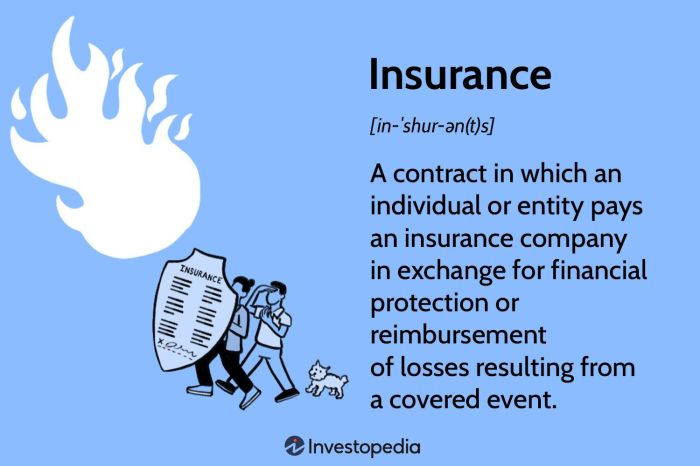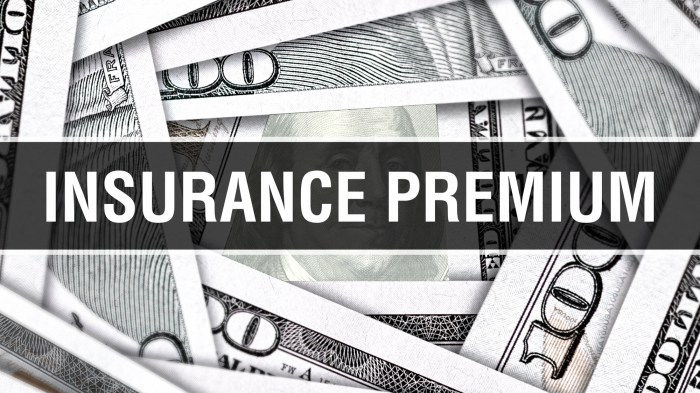Insurance premiums: the price we pay for peace of mind. But what exactly constitutes this often-opaque figure? This guide delves into the multifaceted world of insurance premiums, demystifying their calculation, variations, and impact on our financial well-being. We’ll explore the fundamental components, influencing factors, and various payment options, empowering you with a clearer understanding of this crucial aspect of insurance.
From understanding the core definition and the factors that drive premium calculations to exploring different payment methods and the impact of risk, this guide provides a comprehensive overview. We’ll examine how different insurance types, such as auto, home, and life insurance, influence premium structures and analyze how risk assessment directly affects the final cost. Ultimately, this guide aims to equip you with the knowledge to navigate the world of insurance premiums with confidence.
Types of Insurance Premiums

Insurance premiums vary significantly depending on the type of coverage and several other factors. Understanding these variations is crucial for making informed decisions about your insurance needs. This section will explore the different types of insurance premiums and the factors that influence their cost.
Factors Influencing Insurance Premiums
Several key factors determine the cost of an insurance premium. These include the individual’s risk profile (age, health, driving record, etc.), the coverage amount, the deductible chosen, the insurer’s risk assessment, and the geographic location. For example, a person with a history of accidents will typically pay higher auto insurance premiums than someone with a clean driving record. Similarly, a home in a high-crime area will generally command higher homeowner’s insurance premiums.
Types of Insurance Premiums and Their Variations
The following table summarizes different types of insurance premiums and the factors influencing them. Note that these are general examples and actual premiums will vary based on individual circumstances and the specific insurance provider.
| Type of Insurance | Typical Factors Influencing Premiums | Common Variations |
|---|---|---|
| Term Life Insurance | Age, health, smoking status, policy term length, death benefit amount | Level term, decreasing term, return of premium term |
| Whole Life Insurance | Age, health, smoking status, death benefit amount, cash value accumulation | Various types based on cash value growth and premium payment options |
| Auto Insurance | Driving record, age, vehicle type, location, coverage limits | Liability, collision, comprehensive, uninsured/underinsured motorist |
| Homeowners Insurance | Location, home value, age and condition of the home, coverage limits | Different coverage levels, additional coverage options (e.g., flood, earthquake) |
Premium Structure Comparison: Two Auto Insurance Policies
The following table compares the premium structures of two different auto insurance policies from hypothetical providers, “Insurer A” and “Insurer B,” offering similar coverage for a 30-year-old driver with a clean driving record in a medium-risk area. Note that these are illustrative examples and actual premiums will vary greatly depending on the specifics of the policy and the insurer.
| Feature | Insurer A | Insurer B |
|---|---|---|
| Annual Premium | $1200 | $1000 |
| Deductible (Collision) | $500 | $1000 |
| Deductible (Comprehensive) | $500 | $1000 |
| Liability Coverage | $100,000/$300,000 | $100,000/$300,000 |
Understanding Premium Adjustments and Renewals

Insurance premiums, the price you pay for coverage, aren’t static. Several factors can lead to adjustments, both during the policy’s lifespan and at renewal. Understanding these factors is crucial for managing your insurance costs effectively. This section details the circumstances that can influence premium changes and the process of renewal.
Premium adjustments can occur for various reasons, often related to changes in risk assessment by the insurer. These changes can be triggered by factors related to the insured individual or property, or broader market conditions affecting the insurance industry as a whole. The insurer continuously evaluates the risk associated with providing coverage, and adjustments reflect this ongoing assessment.
Premium Adjustment Circumstances
Several factors contribute to premium adjustments. These include changes in the insured’s risk profile (e.g., a driver’s record showing increased accidents or tickets, a homeowner making significant home improvements that enhance security, or a business improving its safety protocols). External factors such as increased claims costs within a specific geographic area, changes in the cost of reinsurance, or economic inflation can also influence adjustments. In essence, premiums are adjusted to reflect the current and projected risk associated with the policy.
Insurance Premium Renewal Process
The insurance premium renewal process typically involves the insurer reviewing the policy and associated risk factors. This review considers the policyholder’s claims history, any changes in the insured property or individual’s circumstances, and prevailing market conditions. The insurer then calculates a new premium based on this assessment. Policyholders usually receive a renewal notice detailing the new premium amount, effective date, and any changes to the policy’s terms and conditions. This allows policyholders to review the terms and decide whether to accept the renewal or seek alternative coverage.
Factors Influencing Renewal Rates
Renewal rates are influenced by a combination of factors, including the policyholder’s claims history, changes in the insured property or individual’s risk profile, and the overall cost of insurance. A claims-free history generally leads to lower renewal rates, while frequent claims can result in significant increases. Changes in the insured property, such as significant renovations or improvements, can also affect the renewal rate, either positively or negatively depending on the nature of the changes. Finally, broader economic factors and market trends in the insurance industry can influence renewal rates across the board. For example, increased inflation or a rise in the frequency of certain types of claims can lead to higher renewal rates for many policyholders.
Examples of Premium Increases and Decreases
A driver with multiple speeding tickets or a history of accidents can expect a premium increase at renewal. Conversely, a driver with a clean driving record for several years may see their premium decrease. Similarly, a homeowner who installs a sophisticated security system might receive a reduced premium due to the lower risk of burglary, while a homeowner who neglects necessary repairs might see an increase. A business that improves its safety record and reduces workplace accidents might experience a premium decrease, reflecting the lowered risk to the insurer. Conversely, a business with a history of significant claims may face a substantial premium increase at renewal.
Last Word

Understanding insurance premiums is key to making informed decisions about your financial protection. By grasping the factors influencing premium calculations, the various payment options, and the impact of risk assessment, you can effectively manage your insurance costs and ensure you have the appropriate coverage for your needs. This guide serves as a foundational resource, empowering you to navigate the complexities of insurance with greater clarity and control.
Detailed FAQs
What happens if I miss an insurance premium payment?
Missing a payment can lead to policy cancellation or suspension, leaving you without coverage. Late payment fees may also apply.
Can I negotiate my insurance premium?
In some cases, you might be able to negotiate a lower premium by bundling policies, improving your credit score, or taking safety courses (for auto insurance).
How often are insurance premiums reviewed?
Premiums are typically reviewed annually at renewal time. However, some factors might trigger mid-term adjustments.
What is a deductible and how does it affect my premium?
A deductible is the amount you pay out-of-pocket before your insurance coverage kicks in. A higher deductible usually results in a lower premium.